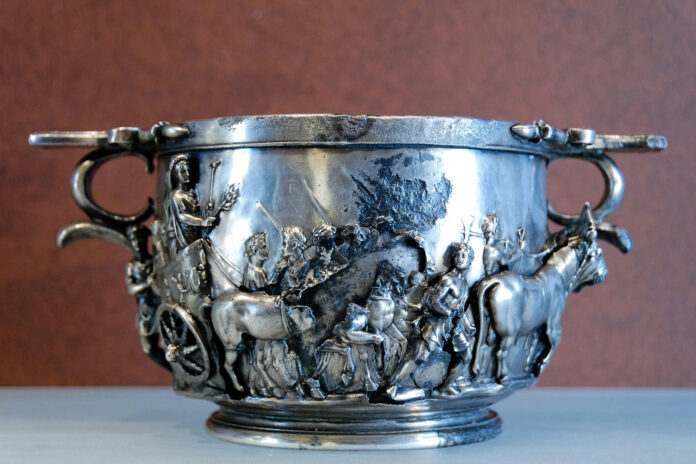In the shadow of Mount Vesuvius, a remarkable artifact emerged from the volcanic ash that once buried Pompeii – a silver drinking cup known as a scyphos. This exquisite piece, preserved by nature’s fury in 79 AD, tells a compelling story of Roman triumph, imperial power, and divine authority through its intricate engravings.
The Masterpiece Unearthed

The two-handled silver cup, discovered in a villa near Pompeii, showcases the pinnacle of Roman craftsmanship and political artistry. Its primary scene depicts future Emperor Tiberius participating in a triumphal parade through Rome’s streets. The detailed engravings show Tiberius riding a horse-drawn chariot, adorned in a toga and carrying symbolic items of power – a laurel branch signifying victory and an eagle-topped scepter representing divine authority from Jupiter himself.
Divine Authority and Triumphal Glory
The Victory Procession
The cup’s main scene captures more than just a parade – it immortalizes a crucial moment in Roman political theater. Tiberius, crowned with a victory wreath by a attending slave, embodies the perfect fusion of military triumph and divine blessing. Such ceremonies were carefully choreographed displays of power that helped maintain the complex social and political hierarchy of the Empire.

Sacred Rituals and Imperial Power
The reverse side of the scyphos reveals an equally significant scene: Tiberius performing a bull sacrifice before Jupiter. This religious ceremony depicts the emperor’s dual role as both political leader and high priest. The sacrifice scene reinforces Tiberius’ position as the empire’s divine intermediary, responsible for maintaining harmony between gods and mortals.
Historical Significance
A Window into Roman Life
This remarkable artifact serves as both a masterpiece of Roman metalwork and a historical document. Its detailed scenes provide invaluable insights into the ceremonial practices, religious rituals, and political propaganda that shaped Roman imperial culture. The scyphos demonstrates how Roman leaders carefully crafted their public image through a combination of military prowess and religious piety.
Legacy in Silver

More than a mere drinking vessel, this scyphos represents a tangible link to Rome’s golden age. Its preservation offers modern scholars and enthusiasts a rare glimpse into the sophisticated ways Romans used art and symbolism to communicate power, legitimacy, and divine favor.
Conclusion: Beyond Mere Artistry
The silver scyphos stands as a testament to Rome’s complex relationship with power, religion, and authority. Through its masterful engravings, we witness how Roman emperors like Tiberius balanced military might with divine blessing, creating a powerful narrative of legitimate rule. This single artifact encapsulates the essence of Roman imperial culture, where military triumph, religious devotion, and political authority merged to create one of history’s most enduring empires.

